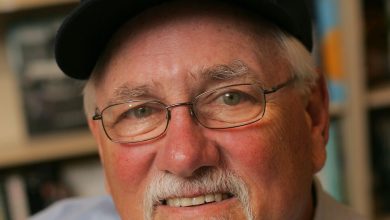Mike Whan Is Changing U.S. Golf

The United States Open is returning this week to the Country Club in Brookline, Mass., one of the five founding clubs of the United States Golf Association. It will be the club’s fourth U.S. Open. Its first, in 1913, when a 20-year-old amateur won, still lives in sports lore.
The club has also hosted several United States Amateur and United States Women’s Amateur tournaments and a Ryder Cup. Founded in the 19th century, it has deep traditions.
But this time around, the United States Golf Association, which chooses the clubs and organizes the U.S. Open and 13 other national championships each year, has at its helm a new chief executive who has cultivated a reputation for being the opposite of a traditionalist. The executive, Mike Whan, is a changemaker, in the parlance of the corporate marketing world he came up in.
For 11 years before joining the U.S.G.A. last year, Whan was the commissioner of the L.P.G.A., taking it from a struggling U.S.-based entity to a thriving global tour with more events and more prize money.
“He rebuilt the tour, and then reimagined its future, by bringing new events, new sponsors and a new value proposition around diversity and inclusion to the L.P.G.A.,” said Vicki Goetze-Ackerman, the L.P.G.A. Tour’s player president, when Whan stepped down. “He has that rare ability to get people of all ages and backgrounds excited and on board with his vision.”
While the U.S.G.A. attracts criticism like any governing body, it has created a wildly lucrative event in the U.S. Open, the revenue from which funds most of the organization’s other championships and initiatives around turf grass and water conservation.
Compared with the PGA Tour, the U.S.G.A. looks even better. The PGA Tour, whose playing privileges were long the goal of professional golfers, is fending off an attack on its status by the new Saudi Arabia-backed LIV Golf Invitational Series, which has lured away many players.
Add in one more factor: Interest in golf from recreational players is still riding a post-pandemic high. If it’s not broke, as the saying goes, what does Whan have to fix?
“Change is in the process,” Whan said in an interview at Merion Golf Club in Pennsylvania. “A 35-year-old Mike Whan would have changed everything. The 57-year-old Mike Whan says, ‘Where am I needed?’ I’m not needed on championship setup. That was Mike Davis’s specialty.”
Davis was Whan’s predecessor, a 31-year veteran of the U.S.G.A. who served as its executive director and then chief executive. He pushed for changes to course setups and tried new things like different heights of rough and giving public courses, including Erin Hills in Wisconsin and Chambers Bay in Washington, a chance at hosting a U.S. Open.
Davis was given credit for trying different approaches around the championships, some more successful than others, but also for investing in some of the less public research projects that the U.S.G.A. funds. But Davis was also criticized, for how he set up courses (too hard) and for how the association regulated equipment (not tightly enough).
“Their No. 1 job should be controlling the equipment,” said Alex Miceli, a longtime golf commentator, referring to the debate over the distance a pro can hit a ball. “The U.S.G.A. did a horrible job with that. It’s like the Federal Reserve saying, ‘Inflation is going to be transitory, inflation is going to be transitory, inflation is going to be transitory.’ Well, it isn’t.”
Whan said in the interview that he had no interest in wading into the course setup debate. That’s the domain of John Bodenhamer, the association’s chief championships officer.
“When I walked into a setup meeting, I said to John, ‘I’m not necessary here, and I might be a detriment,’” Whan said. “The only guidance I’ve given is once you have a plan or a strategy, don’t change it. Don’t let scores or the media change it. Athletes don’t want that. I know that from being the L.P.G.A. commissioner.”
Yet when Whan came on board after last year’s U.S. Open, several senior U.S.G.A. executives left, with the chief commercial officer departing on Whan’s first day in charge and the chief brand officer leaving about a month later.
Whan then did something that no association executive has done: He brought in a title sponsor for one of the organization’s marquee championships. The United States Women’s Open, which dates from 1946, is now the U.S. Women’s Open Presented by ProMedica. The partnership with the health care company nearly doubled the purse to $10 million. When the Australian golfer Minjee Lee won the championship this month, she took home a record $1.8 million first-place check.
Whan said in the interview that his focus was on improving the important things the association did that no one saw.
“On planes, I’d get the question, ‘What does the U.S.G.A. do?’” he said, pulling out a card with “U.S.G.A.” written down the side. “I came up with Unify, Showcase, Govern and Advance.”
And for him the last one is a priority. “‘Advance’ was the big one that was missing,” he said. “We don’t want to preserve; we preserved croquet and that’s not good.”
Big areas of investment are strategies to reduce water usage and to develop junior golfers that way other countries do.
While Whan said he had no desire to tinker with the U.S. Open, he’s also not about to neglect the tournament that brings in around 75 percent of the organization’s revenue.
“The key is not to take it for granted,” he said, drawing a comparison to professional bowling, which dominated weekend television time when he was a child, but has fallen off drastically. “If we take it for granted, there’s no reason we couldn’t end up like bowling.”
He repeated an oft-told story about Jason Gore, a former PGA Tour player who is the senior director of player relations at the U.S.G.A. Where the players win their U.S. Opens matters, Gore told him.
While the men’s side is sewed up with stern tests for the next decade, including Oakmont, Shinnecock Hills, Pebble Beach and Merion, Whan has made a push to have equally prestigious sites for the U.S. Women’s Open, with Riviera, Merion, Pinehurst and Pebble Beach on the roster.
Securing these sites has come with U.S.G.A. investments. At Pinehurst, the association is building a second headquarters. At Pebble Beach, it is building a permanent player pavilion, which the course can use for other events. Taking a long-term view, the organization has done capital improvements to a host site; in the past it has put up and taken down structures.
These initiatives are meant to make it easier for the U.S. Open, an immense logistical undertaking that ties up courses for months, to come back year after year. But it’s also to have sites host other events and work toward his goal of advancing other initiatives.
“I don’t need U.S. Open partners,” Whan said. “I need partners in growing the game. We want to make sure these cathedrals of golf accept the responsibility to host not just the biggest and the most financially lucrative events.”




